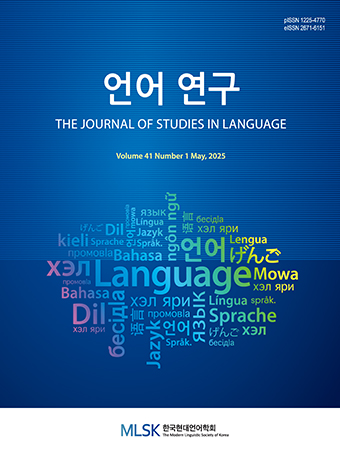Research Article
Abstract
References
Information
Xiangsheng and stand-up comedy are representative comedy genres performed in China and Western countries, respectively. Both performances require only spoken words, and don’t demand complicated stage props. This minimalist form of performance has gained popularity from a wide audience. However, the differences in the production of humor between xiangsheng and stand-up comedy have not been studied well yet. Herein, we compare and analyze xiangsheng and stand-up comedy using relevance theory. The results show that both xiangsheng and stand-up comedy strictly follow relevance theory in the process of creating humor. On the other hand, xiangsheng and stand-up comedy use quite different modes to produce humor, while both of them share a common mechanism in humor production.
- Attardo, S. 1993. Violation of Conversational Maxims and Cooperation: The Case of Jokes. Journal of Pragmatics 19.6, 537-558. 10.1016/0378-2166(93)90111-2
- Attardo, S. 2010. Linguistic Theories of Humor. Berlin: Walter de Gruyter. 10.1515/9783110219029
- Chiaro, D. 2006. The Language of Jokes: Analyzing Verbal Play. London: Routledge. 10.4324/9780203135143
- Clark, B. 2013. Relevance Theory. Cambridge: Cambridge University Press.
- Finkbeiner, R., Meibauer, J., and Schumacher, P. B. 2012. What is a Context? Linguistic Approaches and Challenges. Amsterdam: John Benjamins Publishing Company. 10.1075/la.196
- Goldstein, J. H. 2013. The Psychology of Humor: Theoretical Perspectives and Empirical Issues. Cambridge: Academic Press.
- Horn, L. and Ward, G. 2006. The Handbook of Pragmatics. Oxford: Blackwell. 10.1002/9780470756959
- Lyttle, J. 2007. The Judicious Use and Management of Humor in the Workplace. Business Horizons 50.3, 239-245. 10.1016/j.bushor.2006.11.001
- Ma, Z. and Jiang, M. 2013. Interpretation of Verbal Humor in the Sitcom The Big Bang Theory from the Perspective of Adaptation-relevance Theory. Theory and Practice in Language Studies 3.12, 2220-2226. 10.4304/tpls.3.12.2220-2226
- Morreall, J. 1989. Enjoying Incongruity. Humor 2.1, 1-18. 10.1515/humr.1989.2.1.1
- Norrick, N. R. and Spitz, A. 2008. Humor as a Resource for Mitigating Conflict in Interaction. Journal of Pragmatics 40.10, 1661-1686. 10.1016/j.pragma.2007.12.001
- Pinto, B., Marçal, D., and Vaz, S. G. 2015. Communicating through Humour: A Project of Stand-up Comedy about Science. Public Understanding of Science 24.7, 776-793. 10.1177/0963662513511175 24327672
- Scheel, T. and Gockel, C. 2017. Humor at Work in Teams, Leadership, Negotiations, Learning and Health. Berlin: Springer. 10.1007/978-3-319-65691-5
- Schopenhauer, A. 2016. Arthur Schopenhauer: The World as Will and Presentation. London: Routledge. 10.4324/9781315508573
- Sperber, D. and Wilson, D. 1986. Relevance: Communication and Cognition. Oxford: Blackwell.
- Stebbins, R. A. 1990. Laugh-Makers: Stand-Up Comedy as Art, Business, and Life-Style. Montreal: McGill-Queen’s Press-MQUP.
- Yus, F. 2003. Humor and the Search for Relevance. Journal of Pragmatics 35.9, 1295-1331. 10.1016/S0378-2166(02)00179-0
- Yus, F. 2016. Humour and Relevance. Amsterdam: John Benjamins Publishing Company. 10.1075/thr.4
- Yus, F. 2017. Incongruity-resolution Cases in Jokes. Lingua 197, 103-122. 10.1016/j.lingua.2017.02.002
- Publisher :The Modern Linguistic Society of Korea
- Publisher(Ko) :한국현대언어학회
- Journal Title :The Journal of Studies in Language
- Journal Title(Ko) :언어연구
- Volume : 38
- No :2
- Pages :189-201
- DOI :https://doi.org/10.18627/jslg.38.2.202208.189




 The Journal of Studies in Language
The Journal of Studies in Language






